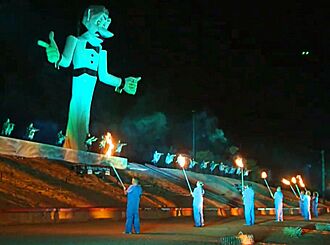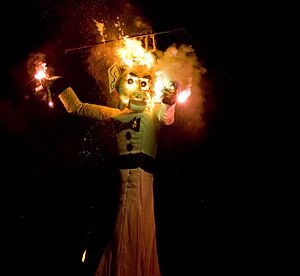Fiestas de Santa Fe facts for kids
Quick facts for kids Fiestas de Santa Fe |
|
|---|---|

Zozobra and fire dancers at the Santa Fe Fiesta
|
|
| Official name | Fiestas de Santa Fe English translation: "Festival of Santa Fe" |
| Also called | Santa Fe Fiesta |
| Observed by | New Mexico |
| Type | Local, Historical, Cultural, Religious |
| Significance | First held on September 16, 1712, to commemorate Diego de Vargas' peaceful return to Santa Fe in Nuevo México |
| Celebrations | The lighting of Zozobra, processions, parades, and New Mexico music performances (typically mariachi) |
| Frequency | annual |
The Fiestas de Santa Fe is a big festival that happens every fall in Santa Fe, New Mexico. It's one of the oldest community celebrations in the United States! The festival is usually held in the second week of September and is filled with parades, music, and special traditions.
Contents
The Story of the Fiesta
The Santa Fe Fiesta has a long and interesting history that has changed over hundreds of years.
How It All Began
The first Fiesta was celebrated way back on September 16, 1712. It was created to remember an important event from 1692. That year, a Spanish general named Don Diego de Vargas led a group of colonists back into Santa Fe.
Twelve years earlier, in 1680, the Spanish had been forced to leave the area by the local Pueblo people during an event called the Pueblo Revolt. After living in exile, de Vargas returned to Santa Fe. The first Fiesta was meant to mark this return and what they hoped would be a time of peace.
A New Vision in the 1900s
For a long time, the Fiesta wasn't celebrated every year. Then, in 1912, a man named Edgar Lee Hewett helped bring it back. He wanted the Fiesta to celebrate the history of all the people of New Mexico. This included the Native Americans, the Hispanic colonists, and the Anglos (people of European descent).
In 1926, a group of artists and writers started their own fun event to protest the main Fiesta charging money for entry. They created a funny parade called the "Hysterical Pageant" and a new tradition: the burning of a giant puppet named Zozobra. These events were so popular that they later became official parts of the Santa Fe Fiesta.
The festival was paused for a few years during World War I (1917–18) and World War II (1942–45).
Changes in Modern Times
Over the years, some people felt that the Fiesta's story of the Spanish return didn't fully respect the Native American point of view. The reenactment of the Spanish return, called "The Entrada," was seen by some as a celebration of conquest, not peace.
In the 2010s, groups of people held silent protests to share historical facts and ask for a more inclusive celebration. After much discussion, the city decided to stop doing "The Entrada" reenactment in 2018. The focus of the Fiesta shifted to celebrating the peaceful co-existence of the different cultures in Santa Fe.
When the COVID-19 pandemic happened in 2020 and 2021, the Fiesta couldn't be held in public. Instead, some events, like the famous burning of Zozobra, were streamed online for everyone to watch safely from home. The full, in-person festival returned in 2022 with lots of music and dancing.
What Happens at the Fiesta?
The Fiesta is packed with exciting events for everyone.
The Burning of Zozobra
The Fiesta officially kicks off with the burning of Zozobra, also known as "Old Man Gloom." Zozobra is a huge marionette puppet, often over 50 feet tall! He is stuffed with paper, which can include old notes, and even police reports from the past year.
As Zozobra burns, he takes all the worries, troubles, and gloom from the past year with him. It's a spectacular show with fire dancers and fireworks, and it gets everyone excited for the happy celebrations to come.
Parades, Music, and More
After Zozobra is gone, the fun continues for three more days. Some of the highlights include:
- Religious Processions: The Fiesta has deep roots in the Catholic faith. It begins with special masses and processions with a historic statue of the Virgin Mary called La Conquistadora. The celebration ends with a beautiful candlelight procession to a landmark called the Cross of the Martyrs.
- Parades: There are several parades, including a Children's Pet Parade where kids show off their pets in costumes, and the Historical/Hysterical Parade, which is a funny and creative look at Santa Fe's history.
- Music and Food: The historic Santa Fe Plaza becomes the heart of the party. It fills up with booths selling delicious food and beautiful arts and crafts. You can hear the lively sound of mariachi bands playing all around the city.
The Fiestas de Santa Fe is a unique event that brings together history, culture, and community fun.



